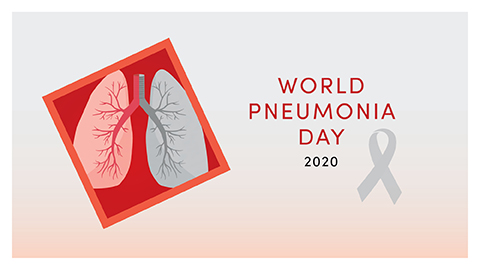World Pneumonia Day 2020
Pneumonia is incredibly common. In 2019 alone, 2.5 million lives worldwide were lost to this infectious disease, over half of which were children. On Nov. 12, 2009, a coalition of global health leaders established World Pneumonia Day to raise awareness, promote pharmaceutical intervention, and generate action to combat pneumonia across the globe. Today, the American Society for Biochemistry and Molecular Biology joins in this effort by explaining this illness and the risks it poses. We also highlight new research by scientists working combat it.

What is pneumonia?
Pneumonia is a potentially serious infection affecting one or both lungs, resulting in inflammation and the buildup of pus and/or fluids in the air sacs, known as alveoli, where gas exchange occurs.
Pneumonia manifests as a mild to severe illness, ranging from moderate flulike symptoms to sepsis, respiratory failure and even death. The range of illness often depends on age, cause of infection, and one’s general health at the time of infection.
While an assortment of germs cause pneumonia, Streptococcus pneumoniae, a resident bacteria of the respiratory tract, is the most common form. Among adults, the influenza virus (the flu) is the traditional cause of viral pneumonia, while the respiratory syncytial virus (RSV) is the leading cause of viral pneumonia in children. Similarly, certain soil-dwelling fungi also promote pneumonia in individuals. For the immunocompromised, or those with chronic health conditions, fungal pneumonia is most common.
Lastly, with the onslaught of the recent pandemic, SARS-COV-2 (the virus that causes COVID-19) is also contributing to increasing cases of pneumonia worldwide.
Research highlight: Pneumonia and bacterial signaling
The pathogen S. pneumoniae is the leading cause of bacterial pneumonia. When the immune system is compromised, this pathogen can transmigrate from the sinuses to the lung’s alveolar cells, causing pulmonary infection. In the Journal of Biological Chemistry, Olotu et al. investigated the mechanisms by which S. pneumonia affects cellular integrity. Specifically, this group was interested in the effects of S. pneumoniae on purinergic signaling, a type of cellular communication that is important for maintaining healthy alveolar cells. The results of this study revealed that S. pneumonia directly inhibits this signaling pathway, therefore reducing overall alveolar cellular function and integrity. This study presents exciting and complex host–pathogen interactions that can impact pneumonia progression.
Research highlight: Pneumonia bacteria rely on their hosts
Fatty acids are the building blocks of fat; in bacteria, fatty acids are used to construct their cell membrane (outer coating). A recent study in JBC by Gullett et al. probes the mechanisms by which the bacteria S. pneumoniae responds to external, host-derived fatty acids. This group discovered that S. pneumoniae build their cellular membrane almost exclusively from these external, host-derived fatty acids. For this to occur, S. pneumoniae suppress the genes required for traditional bacterial fatty acid production. This research group also discovered that S. pneumoniae encodes multiple fatty acid–binding proteins, allowing for host-derived fatty acid construction. Two of these fatty acid–binding proteins were highly similar to those observed in a related bacteria Staphylococcus aureus. Insights in this study can inform on novel therapeutic targets for future treatment against S. pneumoniae infection.
Transmission
Pneumonia transmission manifests through multiple means. According to the Centers for Disease Control and Prevention, the spread of pneumonia can occur in a community-acquired or healthcare-associated fashion, meaning transmission can take place outside the hospital (in the community setting) or after time spent in a healthcare facility, respectively.
Patients who undergo ventilation receive oxygen externally through a tube placed either down their nose or mouth or directly into the trachea (windpipe). In the hospital setting, ventilator-associated pneumonia (VAP) can develop when a patient requires mechanical assistance. While this procedure is effective and life-saving, the presence of a foreign device can introduce germs and cause infection. VAP occurs when these germs enter a patient’s lungs through the ventilation equipment, promoting pneumatic infection.
Hospitals combat VAP through enhanced hygiene protocols and reducing the amount of time spent on the ventilator, for example: frequent cleaning of the patient’s mouth, hand washing before and after touching the patient or ventilator tubes and daily checks on the patient’s ability to breathe independently.
Smoking greatly increases a person’s risk of contracting VAP. Good oral and personal hygiene reduce the risk.
Research highlight: Ventilator-associated pneumonia
Bronchioalveolar lavage, or the insertion of an endoscope into the lungs for sample collection, is the predominant method for diagnosing ventilator-associated pneumonia (VAP). Alternatively, endotracheal aspirates are a less invasive, taking samples from the upper respiratory tract (e.g. sinuses and windpipe). In a recent study in the journal Molecular & Cellular Proteomics, Pathak et al. are the first to characterize the proteome and metabolome in endotracheal aspirates from patients diagnosed with VAP. This study revealed samples from patients with VAP contain metabolites indicative of the host response to VAP, in addition to detectable pathogen peptides. The broader impacts of this study include improvements to early diagnostic methods and treatment for those suffering with ventilator-associated pneumonia.
Diagnosis and treatment
The symptoms of pneumonia can vary from mild to severe, therefore initial diagnosis can be difficult. Often, physicians will perform a physical exam, followed by diagnostics such as blood tests or mucus samples to confirm infection and determine the source pathogen.
Another diagnostic tool that physicians use is the chest X-ray; the X-ray provides a picture of your lungs, showing sites of inflammation or fluid buildup. In the hospital setting, patients may also undergo a CT scan, which can give a clearer, in-depth view of the lungs and any potential complications.
Once you are diagnosed with pneumonia, your physician will determine a treatment plan; often, this depends on the infectious agent (bacteria, virus or fungi). In the case of bacterial pneumonia, antibiotics are often prescribed. It is important to note that completing the course of antibiotic medication is vital to recovery; stopping medication early can lead to reinfection or the onset of antibiotic resistance. Viral pneumonia often requires an alternate course of treatment, usually in the form of antiviral medications. Similarly, fungal pneumonia infections are treated with antifungal drugs, of which often require administration over several weeks.
Prevention
Pneumonia can affect people of all ages, but there are simple measures you can take to prevent pneumatic infection, such as keeping your vaccinations up to date. According to the CDC, routine vaccinations can lower your risk for pneumonia by reducing the risk of infection by other pneumonia-causing pathogens.
Currently, two pneumonia-specific vaccines are available in the United States and are recommended for different age groups; these include the pneumococcal conjugate vaccine (PCV13) and pneumococcal polysaccharide vaccine (PPSV23).
While vaccines cannot prevent all cases of pneumonia, research demonstrates the pneumococcal vaccines exhibit considerable protection in infants, adults and the elderly against invasive and pneumococcal pneumonia.
Aside from vaccinations, adopting and maintaining a healthy lifestyle can also reduce your risk of contracting pneumonia. Maintaining a healthy diet, exercising and getting an adequate amount of sleep all help to reduce the risk of respiratory illness.
For those living with lung disease, the American Lung Association encourages regular exercise, defined as 30 minutes per day, five days a week, to increase lung strength. Physical activity of this kind also reduces the risk of serious illness, such as lung cancer.
While aerobic exercise is beneficial for muscle and lung strength, relaxing breathing exercises enhance lung capacity and function. For individuals suffering with breathing conditions such as asthma or chronic obstructive pulmonary disease, five to 10 minutes a day of exercises, such as diaphragmatic or pursed-lip breathing, have shown to increase lung capacity and efficiency.
Enjoy reading ASBMB Today?
Become a member to receive the print edition monthly and the digital edition weekly.
Learn moreGet the latest from ASBMB Today
Enter your email address, and we’ll send you a weekly email with recent articles, interviews and more.
Latest in Science
Science highlights or most popular articles

New study finds potential targets at chromosome ends for degenerative disease prevention
UC Santa Cruz inventors of nanopore sequencing hail innovative use of their revolutionary genetic-reading technique.

From the journals: JLR
How lipogenesis works in liver steatosis. Removing protein aggregates from stressed cells. Linking plasma lipid profiles to cardiovascular health. Read about recent papers on these topics.

Small protein plays a big role in viral battles
Nef, an HIV accessory protein, manipulates protein expression in extracellular vesicles, leading to improved understanding of HIV-1 pathogenesis.

Genetics studies have a diversity problem that researchers struggle to fix
Researchers in South Carolina are trying to build a DNA database to better understand how genetics affects health risks. But they’re struggling to recruit enough Black participants.

Scientists identify new function of learning and memory gene common to all mammalian brain cells
Findings in mice may steer search for therapies to treat brain developmental disorders in children with SYNGAP1 gene mutations.

From the journals: JBC
Biased agonism of an immune receptor. A profile of missense mutations. Cartilage affects tissue aging. Read about these recent papers.

